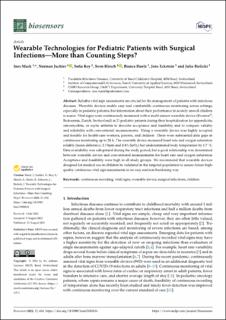Please use this identifier to cite or link to this item:
https://doi.org/10.21256/zhaw-25506Full metadata record
| DC Field | Value | Language |
|---|---|---|
| dc.contributor.author | Mack, Ines | - |
| dc.contributor.author | Juchler, Norman | - |
| dc.contributor.author | Rey, Sofia | - |
| dc.contributor.author | Hirsch, Sven | - |
| dc.contributor.author | Hoelz, Bianca | - |
| dc.contributor.author | Eckstein, Jens | - |
| dc.contributor.author | Bielicki, Julia | - |
| dc.date.accessioned | 2022-08-29T08:34:34Z | - |
| dc.date.available | 2022-08-29T08:34:34Z | - |
| dc.date.issued | 2022-08-12 | - |
| dc.identifier.issn | 2079-6374 | de_CH |
| dc.identifier.uri | https://digitalcollection.zhaw.ch/handle/11475/25506 | - |
| dc.description.abstract | Reliable vital sign assessments are crucial for the management of patients with infectious diseases. Wearable devices enable easy and comfortable continuous monitoring across settings, especially in pediatric patients, but information about their performance in acutely unwell children is scarce. Vital signs were continuously measured with a multi-sensor wearable device (Everion®, Biofourmis, Zurich, Switzerland) in 21 pediatric patients during their hospitalization for appendicitis, osteomyelitis, or septic arthritis to describe acceptance and feasibility and to compare validity and reliability with conventional measurements. Using a wearable device was highly accepted and feasible for health-care workers, parents, and children. There were substantial data gaps in continuous monitoring up to 24 h. The wearable device measured heart rate and oxygen saturation reliably (mean difference, 2.5 bpm and 0.4% SpO2) but underestimated body temperature by 1.7°C. Data availability was suboptimal during the study period, but a good relationship was determined between wearable device and conventional measurements for heart rate and oxygen saturation. Acceptance and feasibility were high in all study groups. We recommend that wearable devices designed for medical use in children be validated in the targeted population to assure future high-quality continuous vital sign assessments in an easy and non-burdening way. | de_CH |
| dc.language.iso | en | de_CH |
| dc.publisher | MDPI | de_CH |
| dc.relation.ispartof | Biosensors | de_CH |
| dc.rights | http://creativecommons.org/licenses/by/4.0/ | de_CH |
| dc.subject | Continuous recording | de_CH |
| dc.subject | Vital sign | de_CH |
| dc.subject | Wearable device | de_CH |
| dc.subject | Surgical infection | de_CH |
| dc.subject | Child | de_CH |
| dc.subject.ddc | 610.28: Biomedizin, Biomedizinische Technik | de_CH |
| dc.subject.ddc | 618.92: Pädiatrie | de_CH |
| dc.title | Wearable technologies for pediatric patients with surgical infections : more than counting steps? | de_CH |
| dc.type | Beitrag in wissenschaftlicher Zeitschrift | de_CH |
| dcterms.type | Text | de_CH |
| zhaw.departement | Life Sciences und Facility Management | de_CH |
| zhaw.organisationalunit | Institut für Computational Life Sciences (ICLS) | de_CH |
| dc.identifier.doi | 10.3390/bios12080634 | de_CH |
| dc.identifier.doi | 10.21256/zhaw-25506 | - |
| zhaw.funding.eu | No | de_CH |
| zhaw.issue | 8 | de_CH |
| zhaw.originated.zhaw | Yes | de_CH |
| zhaw.pages.start | 634 | de_CH |
| zhaw.publication.status | publishedVersion | de_CH |
| zhaw.volume | 12 | de_CH |
| zhaw.publication.review | Peer review (Publikation) | de_CH |
| zhaw.webfeed | Biomedical Simulation | de_CH |
| zhaw.webfeed | Medical Image Analysis & Data Modeling | de_CH |
| zhaw.funding.zhaw | Smart Hospital – Integrierter Rahmen, Instrumente und Lösungen (SHIFT) | de_CH |
| zhaw.author.additional | No | de_CH |
| zhaw.display.portrait | Yes | de_CH |
| Appears in collections: | Publikationen Life Sciences und Facility Management | |
Files in This Item:
| File | Description | Size | Format | |
|---|---|---|---|---|
| 2022_Mack-etal_Wearable-technologies-pediatric-patients-surgical-infections.pdf | 934.51 kB | Adobe PDF |  View/Open |
Show simple item record
Mack, I., Juchler, N., Rey, S., Hirsch, S., Hoelz, B., Eckstein, J., & Bielicki, J. (2022). Wearable technologies for pediatric patients with surgical infections : more than counting steps? Biosensors, 12(8), 634. https://doi.org/10.3390/bios12080634
Mack, I. et al. (2022) ‘Wearable technologies for pediatric patients with surgical infections : more than counting steps?’, Biosensors, 12(8), p. 634. Available at: https://doi.org/10.3390/bios12080634.
I. Mack et al., “Wearable technologies for pediatric patients with surgical infections : more than counting steps?,” Biosensors, vol. 12, no. 8, p. 634, Aug. 2022, doi: 10.3390/bios12080634.
MACK, Ines, Norman JUCHLER, Sofia REY, Sven HIRSCH, Bianca HOELZ, Jens ECKSTEIN und Julia BIELICKI, 2022. Wearable technologies for pediatric patients with surgical infections : more than counting steps? Biosensors. 12 August 2022. Bd. 12, Nr. 8, S. 634. DOI 10.3390/bios12080634
Mack, Ines, Norman Juchler, Sofia Rey, Sven Hirsch, Bianca Hoelz, Jens Eckstein, and Julia Bielicki. 2022. “Wearable Technologies for Pediatric Patients with Surgical Infections : More than Counting Steps?” Biosensors 12 (8): 634. https://doi.org/10.3390/bios12080634.
Mack, Ines, et al. “Wearable Technologies for Pediatric Patients with Surgical Infections : More than Counting Steps?” Biosensors, vol. 12, no. 8, Aug. 2022, p. 634, https://doi.org/10.3390/bios12080634.
Items in DSpace are protected by copyright, with all rights reserved, unless otherwise indicated.